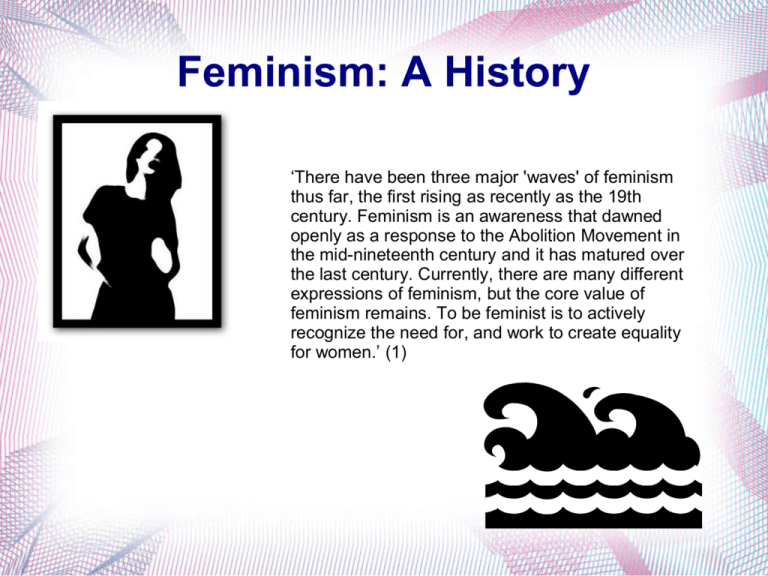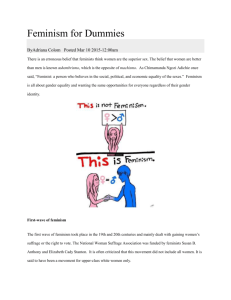
Feminism: A History
‘There have been three major 'waves' of feminism
thus far, the first rising as recently as the 19th
century. Feminism is an awareness that dawned
openly as a response to the Abolition Movement in
the mid-nineteenth century and it has matured over
the last century. Currently, there are many different
expressions of feminism, but the core value of
feminism remains. To be feminist is to actively
recognize the need for, and work to create equality
for women.’ (1)
First Wave Feminism
First-wave feminism refers to a period of feminist activity
during the nineteenth and early twentieth century in the
United Kingdom and the United States. It focused primarily
on gaining women's suffrage (the right to vote).
United Kingdom
Mary Wollstonecraft published one of the first feminist
treatises in Britain, A Vindication of the Rights of Woman
(1792), in which she advocated the social and moral
equality of the sexes, extending the work of her 1790
pamphlet, A Vindication of the Rights of Man. Her later
unfinished work "Maria, or the Wrongs of Woman" earned
her considerable criticism as she discussed women's
sexual desires.
Wollstonecraft is regarded as the grandmother of British feminism and her ideas
shaped the thinking of the suffragettes, who campaigned for the women's vote. After
generations of work, this was eventually granted - to some women in 1918, and
equally with men in 1928.
Today Wollstonecraft is regarded as one of the founding feminist philosophers, and
feminists often cite both her life and work as important influences.
Early 20th century
During the early 20th century English women achieved civil
equality, in theory. World War I saw more women go to work
outside the home. Women gained the right to sit in
parliament, although it was only slowly that women were
actually elected. Women started serving on school boards
and local bodies, and numbers kept increasing after the war.
This period also saw more women starting to become more
educated.
A Matrimonial Causes Act in 1923 gave women the right to
the same grounds for divorce as men. However the
recession which started in the 1920s meant unemployment
rose, which women were the first to face. Many feminist
writers and women's rights activists argued that it was not
equality to men which they needed but a recognition of what
women need to fulfil their potential of their own natures, not
only within the aspect of work but society and home life too.
Virginia Woolf produced her essay A Room of One's Own based on the ideas of women as
writers and characters in fiction. Woolf said that a woman must have money and a room of
her own to be able to write.
United States of America
Woman in the Nineteenth Century by Margaret Fuller has been considered the first
major feminist work in the United States and is often compared to Wollstonecraft's A
Vindication of the Rights of Woman. Prominent leaders of the feminist movement in
the United States include Lucretia Coffin Mott, Elizabeth Cady Stanton, Lucy Stone,
and Susan B. Anthony; all of whom campaigned for the abolition of slavery prior to
championing women's right to vote.
The majority of first-wave feminists were
more moderate and conservative than
radical or revolutionary; they were willing to
work within the political system and they
understood the clout of joining with
sympathetic men in power to promote the
cause of suffrage.
The end of the first wave is often linked with
the passage of the Nineteenth Amendment
to the United States Constitution (1920),
granting women the right to vote. This was
the major victory of the movement, which
also included reforms in higher education,
in the workplace and professions, and in
health care.
Second Wave Feminism
Second-wave feminism refers to the period of activity in the early 1960s and lasting
through the late 1980s.
Whereas first-wave feminism focused mainly on overturning legal obstacles to equality
(i.e. voting rights, property rights), second-wave feminism successfully addressed a
wide range of unofficial inequalities associated with sexuality, family, the workplace,
and, perhaps most controversially, reproductive rights.
The scholar Imelda Whelehan suggests that the second wave was a continuation of
the earlier phase of feminism involving the suffragettes in the UK and USA. Secondwave feminism has continued to exist since that time and coexists with what is termed
third-wave feminism.
The scholar Estelle Freedman compares first and second-wave feminism saying that
the first wave focused on rights such as suffrage, whereas the second wave was
largely concerned with other issues of equality, such as ending discrimination.
.
Simone de Beauvoir and The
Second Sex
The French author and philosopher Simone de Beauvoir is now best known for her
treatise The Second Sex, a detailed analysis of women's oppression and an influential
text of contemporary feminism.
It sets out a feminist philosophy which prescribes a moral
revolution. She argues women have historically been
considered deviant and abnormal and contends that even
Mary Wollstonecraft considered men to be the ideal
toward which women should aspire.
In it she argues that women throughout history have been
defined as the ‘other’ sex, an aberration from the ‘normal’
male sex.
De Beauvoir argues that for feminism to move forward,
this attitude must be set aside.
The Feminine Mystique
Betty Friedan's The Feminine Mystique (1963) criticized the idea that women could
only find fulfillment through childrearing and homemaking.
According to Friedan's obituary in the The New York Times, The Feminine Mystique
‘ignited the contemporary women's movement in 1963 and as a result permanently
transformed the social fabric of the United States and countries around the world’ and
‘is widely regarded as one of the most influential nonfiction books of the 20th
century’.(2)
In the book, Friedan hypothesizes that women are
victims of a false belief system that requires them to
find identity and meaning in their lives through their
husbands and children. Such a system causes
women to completely lose their identity in that of their
family. Friedan specifically locates this system among
post-World War II middle-class suburban
communities. At the same time, America's post-war
economic boom had led to the development of new
technologies that were supposed to make household
work less difficult, but that often had the result of
making women's work less meaningful and valuable
1950s Culture
1950s: Sexual Repression or
Obsession?
‘While sexual desires were recognized as a fact of lie, western society sought to
contain sexuality within the confines of marriage. But the sexual revolution of the
1960s began in the 1950s.
The strict moral codes of the 1950s created a paradox in that a society which sought
to contain sexuality was obsessed with sexuality.
Hugh Hefner created an empire catering to male sexual fantasies, and Marilyn
Monroe, the sexual icon of the era, was an unique combination of smoldering
sensuality and child-like innocence.’
www.history.com/classroom
Sexual Revolution
During the 1960s, shifts in regards to how society viewed sexuality began to
take place, heralding a period of de-conditioning in some circles away from old
world antecedents, and developing new codes of sexual behaviour.
The 1960s heralded a new culture of ‘free love’ with millions of young people in
the Western World embracing the hippie ethos and preaching the power of love
and the beauty of sex as a natural part of ordinary life. Hippies believed that
sex was a natural biological phenomenon which should not be denied or
repressed. The feminist movement embraced this sexual liberation of women.
Sexual liberalisation heralded a new ethos in experimenting with sex in and
outside of marriage,contraception and the pill, public nudity, and liberalisation of
abortion.
Reflection
Third Wave Feminism
Third-wave feminism is a term identified with several diverse strains of feminist activity
and study from 1990 to the present.
The movement arose as a response to perceived possible failures and backlash
against initiatives and movements created by second-wave feminism of the 1960s
through the 1970s and the realisation that women are of many colours, ethnicities,
nationalities, religions and cultural backgrounds.
The third wave embraces
contradictions and conflict, and
accommodates diversity and
change.There is however no allencompassing single feminist
idea.
Proponents of third-wave
feminism claim that it allows
women to define feminism for
themselves by incorporating their
own identities into the belief
system of what feminism is and
what it can become through one's
own perspective.
In their introduction to the idea of third-wave feminism in Manifesta, authors Jennifer
Baumgardner and Amy Richards suggest that feminism can change with every
generation and individual:
‘We're not doing feminism the same way that the seventies feminists did it; being
liberated doesn't mean copying what came before but finding one's own way-- a
way that is genuine to one's own generation.’ (3)
Some contemporary feminists, such as Katha Pollitt or Nadine Strossen, consider
feminism to hold simply that ‘women are people’.(4)
Views that separate the sexes rather than unite them are considered by these writers
to be sexist rather than feminist.
Third-wave feminism's central issues are that of race, social class and sexuality.
However, they are also concerns of workplace issues such as the glass ceiling, sexual
harassment, unfair maternity leave policies, motherhood—support for single mothers
by means of welfare and child care and respect for working mothers and mothers who
decide to leave their careers to raise their children full-time.
Third-wave feminists want women to be seen as intelligent, political beings with
intelligent, political minds; some claim that there is a lack of diverse, positive female
representatives in pop culture. They also want to put attention to alleged unhealthy
standards for women in media; the glamorization of eating disorders; the portrayal of
women as sexualized objects catering solely to the man’s needs, and antiintellectualism.
Women Empowered or
Repressed?
References
1. What is Feminism? (www.essortment.com)
2. Fox, Margalit Betty Friedan: Who Ignited Cause in 'Feminine Mystique,' Dies at 85 (The New York Times, February 5, 2006)
3. Baumgardner, Jennifer; Amy Richards: ManifestA: Young Women, Feminism, and
the Future. (New York: Farrar, Straus and Giroux)
4. Pollitt, Katha, Reasonable Creatures: Essays on Women and Feminism (Vintage,
1995)









